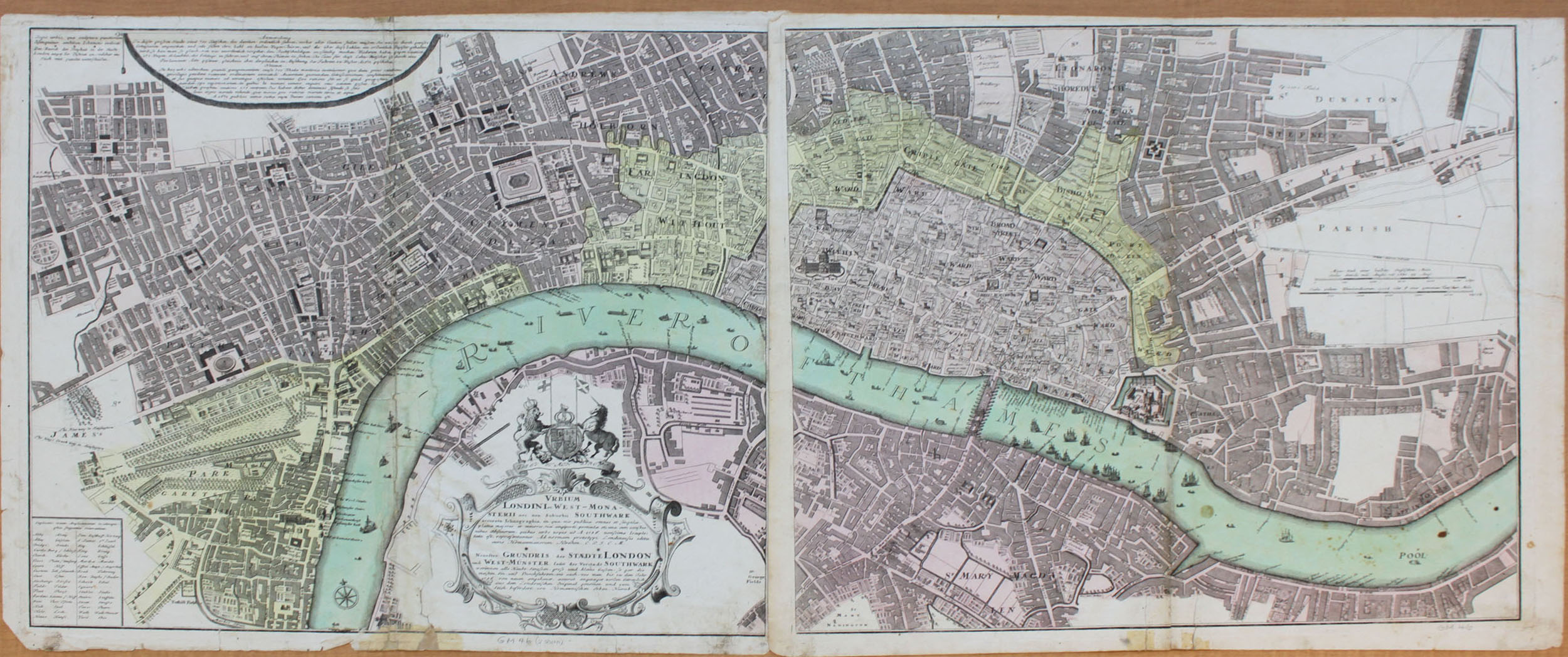This post was written by Simone Hawkins, Reference Assistant in Research Services. She is pursuing her Bachelor’s Degree in Music here at George Mason University and Baroque music is her area of interest.

Part of the Vrbium Londini map by Christophe Homann from the C. Harrison Mann, Jr. Map Collection #C0213, Folder 46, Special Collections Research Center, George Mason University Libraries.
Complementing our first #musicmonday post, which highlighted Georg Friedrich Händel’s very famous set of orchestral suites entitled The Celebrated Water Musick (M1003.H22 W3 1788) HWV 348-350*, is this color copperplate engraving Vrbium Londini by Christophe Homann (1703-1730) from the C. Harrison Mann, Jr. Map Collection #C0213. As a B.A. Music major at George Mason University (GMU), and newly employed at the Special Collections Research Center for the summer, I took some time to familiarize myself with the music materials when I discovered this map of London as well as our version of Water Musick. Originally, I was not searching for anything in particular in browsing these collections, when I realized the significance of these finds.
The map itself is a window into what it was like in Baroque-era England. What palaces, churches, and institutions were drawn and labeled gives an idea of the prominence of these locations. Seeing the archaic spellings of streets and different names of familiar London landmarks also helps to get a sense of the language that was used at the time.
It was published in 1736 – a year in which Georg Friedrich Händel (1685-1759), William Boyce (1711-1779), and John Weldon (1676-1736) were active musicians. The description of the map is both in Latin and German, however, the streets and place names are labeled in English. This is a particularly interesting feature as Händel himself was a German-born composer who later lived and worked in England.

Title text area of map featuring the Coat of Arms of Great Britain. C. Harrison Mann, Jr. Map Collection #C0213, Folder 46, Special Collections Research Center, George Mason University Libraries.
Ah, the year 1736 – a prolific one for Händel! Among the many musical works he premiered and composed that year were Alexander’s Feast (oratorio), Atalanta (opera), and two organ concerti (Op. 4 No. 1, & No. 6).
Key places where Händel, Boyce, and Weldon worked and presented music are depicted beautifully in miniatures of these landmarks:
On 17 July 1717, King George I and his royal boat party set out from Whitehall Palace (beneath Inner Scotland Yard in this close-up) towards Chelsea, upon the Thames. On this occasion, he was treated to the first performance of Händel’s Water Musick. It is said that the King enjoyed this music so much, he requested it to be played at least three times throughout the voyage, including on the return trip.

Closeup of White Hall and St. Peters Abby. C. Harrison Mann, Jr. Map Collection #C0213, Folder 46, Special Collections Research Center, George Mason University Libraries.
Known especially for his trumpet voluntaries, William Boyce was employed as an organist at Oxford Chapel (currently named St. Peter, Vere Street) from 1734 to 1736. He was also appointed as the Master of the King’s Musick from 1755 to 1760. When he died in 1779, he was buried at St. Paul’s Cathedral.
Alexander’s Feast was first performed at Covent Garden Theatre on the 19th of February, 1736. Covent Garden Theatre was also the place of the first London performance of one of Händel’s most famous works – the Messiah (from which you may recognize the Hallelujah Chorus, a staple of holiday season concerts) – on 23 March 1743.
The Academy of St. Martin in the Fields, an ensemble based out of London, recorded the Messiah using the 1743 version that Handel used in its London premiere. They are (as far as is known) the only ensemble to perform from this score.**
The approximate location on the map below, of what is now called the Royal Opera House, is on the first block to the right of “Covent Garden Market”, between Bow/Charles Street and Tavistock Street.

The Covent Garden Market area of the map by Christophe Homann from the C. Harrison Mann, Jr. Map Collection #C0213, Folder 46, Special Collections Research Center, George Mason University Libraries.
At [the church of] St. Martin-in-the-Fields, just below the center of this image along St. Martin’s Court, John Weldon was organist. He served here from 1714 to 1736, until he died on 7 May 1736.

A closeup of St. Martin-in-the-Fields. C. Harrison Mann, Jr. Map Collection #C0213, Folder 46, Special Collections Research Center, George Mason University Libraries.
Händel, who died on 14 April 1759, was buried at St. Peters Abby – called Westminster Abbey today.

A closeup of St. Peters Abby. Vrbium Londini map by Christophe Homann from the C. Harrison Mann, Jr. Map Collection #C0213, Folder 46, Special Collections Research Center, George Mason University Libraries.
You can explore other works of Händel in our collections – Susanna: an oratorio (M2000.H22 S87 1749), Selections from Sonatas, Op. 1 (M178.H24 T94), and L’Allegro, il Pensieroso ed il Moderato (M2000.H22 A55 1795).
*HWV stands for Händel-Werke-Verzeichnis, the catalogue of all his authenticated works, in categories of musical genre. It was published between 1978 and 1986 by Bernd Baselt in German.
**This ensemble, who has performed at George Mason University’s Center for the Arts (Fairfax Campus) for the past few years will be returning once more this season, 2018-2019, and will be giving a concert at GMU’s Hylton Performing Arts Center on October 14th.
Sources:
Follow Special Collections Research Center on Social Media at our Facebook, Instagram, and Twitter accounts. To search the collections held at Special Collections Research Center, go to our website and browse the finding aids by subject or title. You may also e-mail us at speccoll@gmu.edu or call 703-993-2220 if you would like to schedule an appointment, request materials, or if you have questions. Appointments are not necessary to request and view collections.

